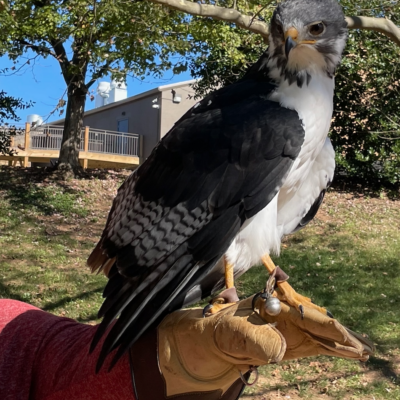|
Reko Rennie’s (pictured) graffiti installation opens at the Kluge-Ruhe Aboriginal Art Collection this week. Rennie and Native American Artist Frank Buffalo Hyde will also collaborate on a mural, which will be unveiled at The Bridge/PAI in February. |
High drama was in the air at the Kluge-Ruhe Aboriginal Art Collection last week when I went to preview an installation by the Aboriginal artist Reko Rennie. Rennie had never worked with the spray paints the museum had provided for him, and the colors weren’t rich enough to cover a black base. Incidentally, Rennie had already covered one of the Kluge-Ruhe’s gallery spaces in a claustrophobic black and hung the walls with diamond-shaped stencils.
O.K., so “high drama” is a bit of an overstatement. But if you’ve been on the Downtown Mall in recent weeks and checked out the two big, pink kangaroos plastered to the inside of an empty storefront window—a bit of mystery marketing for the show, courtesy of CommonPlace Arts—you already know that Rennie’s work is pretty damn dramatic. More dramatic than Rennie, at least, who seemed happy to wait another couple of days for the right spray paint to arrive.
Stephen Gilchrist, an Australian curator studying in New York who is collaborating with Rennie for the project, said that the the Kluge-Ruhe had been looking for a young, urban artist (not a photographer) who reflected the concerns of aboriginals living in Australian cities. Rennie grew up in the suburbs west of Melbourne, where an early interest in graffiti—which fit in with other interests like hip hop and break dancing—put him at odds with cops. “As a teenager, it’s important to express your identity,” says Rennie, whose father is also an artist.
It just turns out that the identity that he was trying to express was particularly complicated. “A lot of people have the idea of Aboriginals walking around with the lap-lap”—like a loin cloth—“and a spear. Whatever. There’s a real diversity among Aboriginal people. I identify as an Aboriginal dude,” he says, but more so, “I identify as an artist who incorporates my background and expresses it in my work.”
Rennie, who is 36, became a full-time artist in 2009 after spending years as a journalist, many with Melbourne’s The Age. Since then, he’s won an Australian Council of the Arts residency at the Cité Internationale des Arts in Paris. To have started as a graffiti artist, to have no formal training, and now to be painting (with spray paint, no less) around the crown molding inside a property owned by a noted American institution, says Rennie, “is big.” “I have so much more of a voice with art than I ever did with journalism.”
“That’s the world we live in now,” says Gilchrist, the curator. Where once, only the work of old masters was worthy of museum exhibition, “All cultural production is valued for its own intrinsic worth. That’s a positive of globalization.”
The installation at Kluge-Ruhe (presuming the suitable paints ever got there) combines the mass-produced neons of Andy Warhol and the bold, imperfect patterns of traditional Aboriginal art known to regular Kluge-Ruhe visitors. Gilchrist calls it post-graffiti art, which in recent years has gone from the street to the gallery, and whose central concerns include disaffected youth and cultural invisibility. The dizzying diamond patterns beneath the kangaroo that dominate the installation refer to one of four male symbols in the Kamilaroi language group.
Those patterns, as well as the “patter” of national discourse surrounding the native peoples of America and Australia, inform the installation’s title, “Patternation.” As part of Rennie’s residency, he will collaborate with Frank Buffalo Hyde, a Native American (Nez Perce/Onondaga) artist living in Pittsburgh, who similarly combines traditional craft with modern forms in fresh expressions of modern native identity.
Rennie, Hyde and UVA’s Dean Dass speak at a symposium called “Beyond Walls,” in room 153 of UVA’s Campbell Hall at 9:30am on Friday, January 28. “Patternation” opens with a reception on January 28 at the Kluge-Ruhe Aboriginal Art Collection, from 5:30-7:30pm.
/Reko-roo-detail-crop.jpg)





